
BIOS and Overclocking …
Get fast to the right UEFI settings …
BIOS and Overclocking
UEFI BIOS Update
ASRock H170 Combo overclocking
ASRock H170 Combo memory settings
ASRock H170 Combo voltage settings
Overclock even easier
BIOS undervolting
Fan control
Energy consumption
BIOS and overclocking …
Let us continue with the BIOS / UEFI Setup options and the UEFI overclocking. By pressing F2 or Del during PC boot, you get access to the UEFI Setup.
The ASRock H170 Combo UEFI BIOS has a graphical interface that allows intuitive operation with the mouse or can still be conventionally operated with a keyboard.
A great, new feature for beginners is the ASRock EZ Mode – so Easy Mode, providing a clear start page with the most important information and still not seems overloaded.
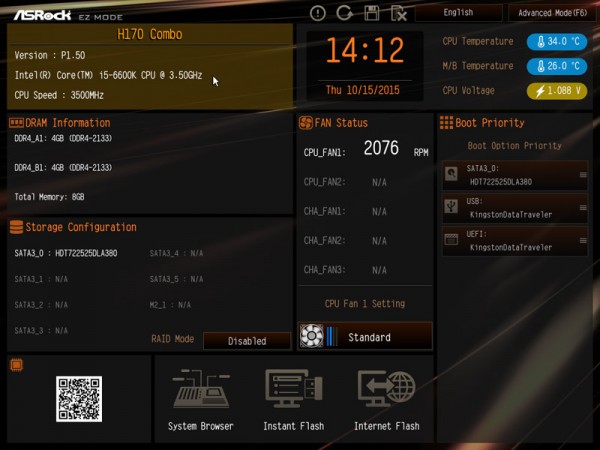
In addition to basic information such as time, date, CPU temperature, motherboard temperature and fan speeds, you can see important details about the hardware. You also find an adjustment of the fans with one click.
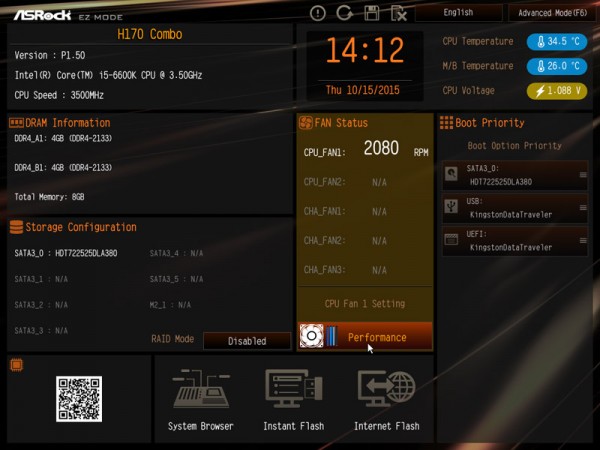
If you like to get more details about the installed hardware, there is also the System Browser view, where you can view graphically the motherboard components installed.
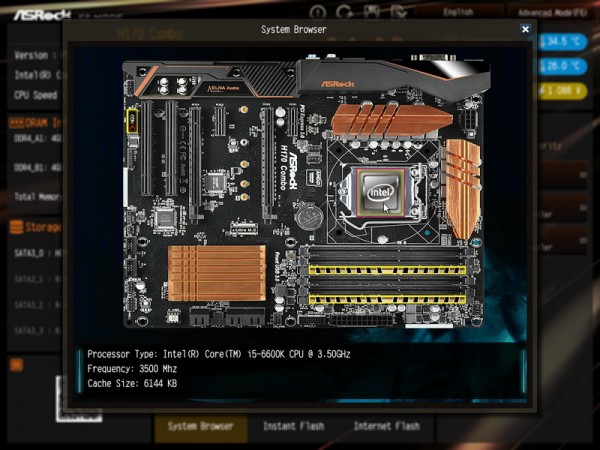
You can get more information with a click on the component and with a click on the I/O panel you can see the installed devices of each port.
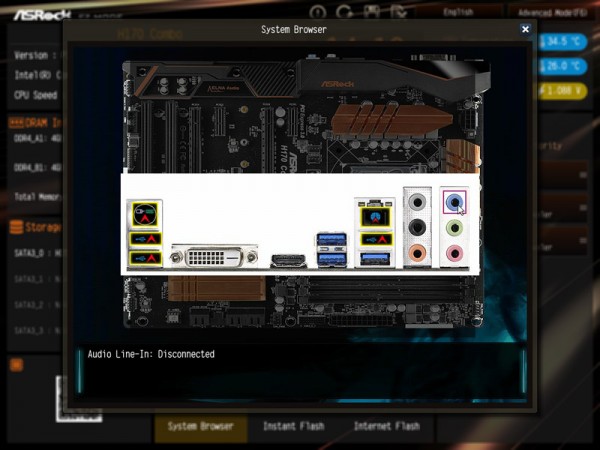
Of course, you can also set the time and date.
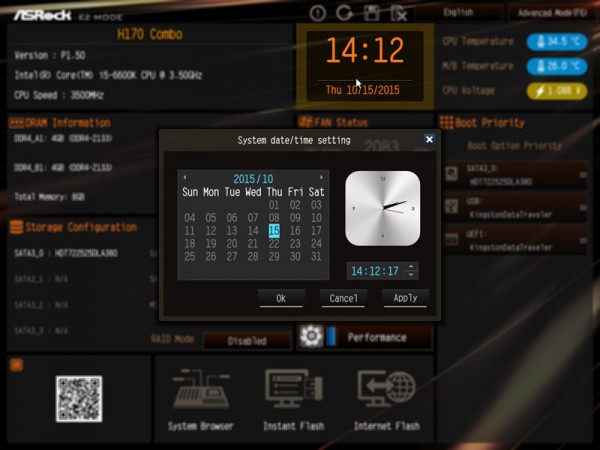
More functions can be activated with keyboard shortcuts or using the F-key.
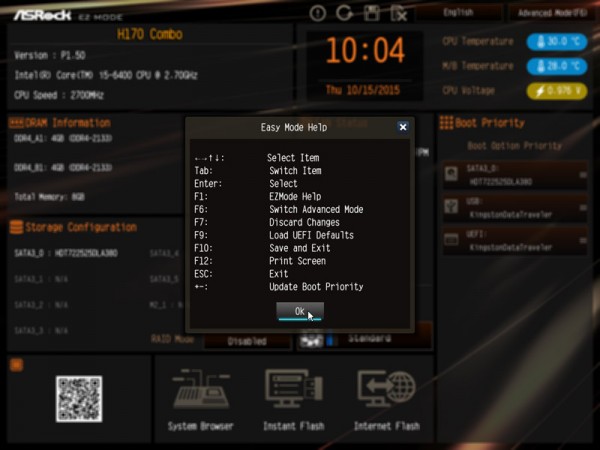
And with the F6 key you can get back to the ASRock advanced mode after a short confirm, which you can also set as standard option – good job, we really like this feature !
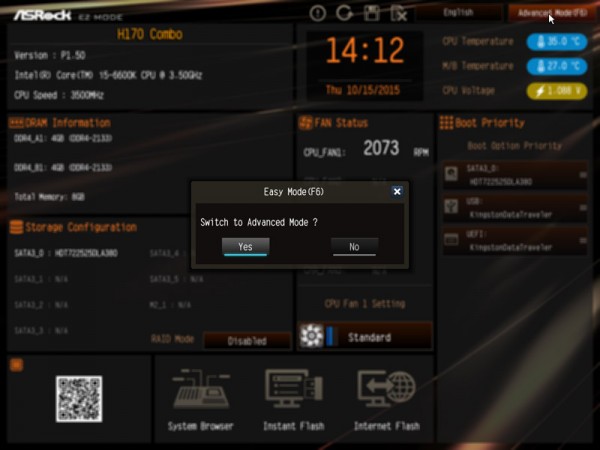
In Advanced Mode at the first screen you can see the UEFI version, a language selection, the Easy Mode button and the My Favorite menu item, the CPU used, the installed DDR4 memory with dual channel support.
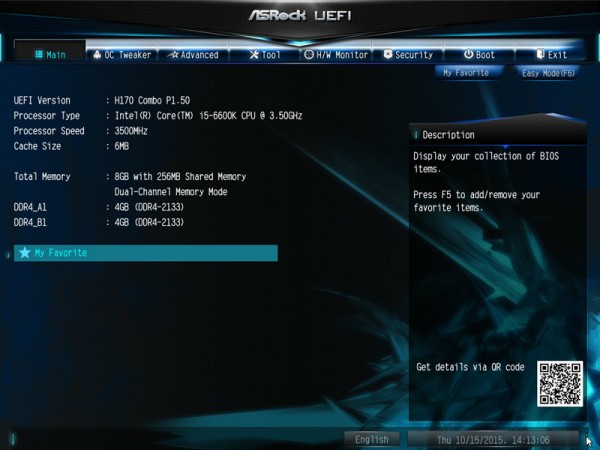
Or the installed DDR3 memory with dual channel support.
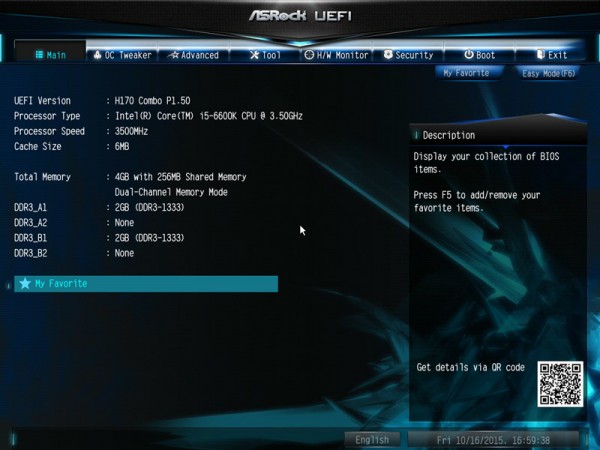
This My Favorite feature is very useful, because you can put here often-needed menu items by simply selecting the desired button, then press F5 and the feature is added to the my favorite overview page.
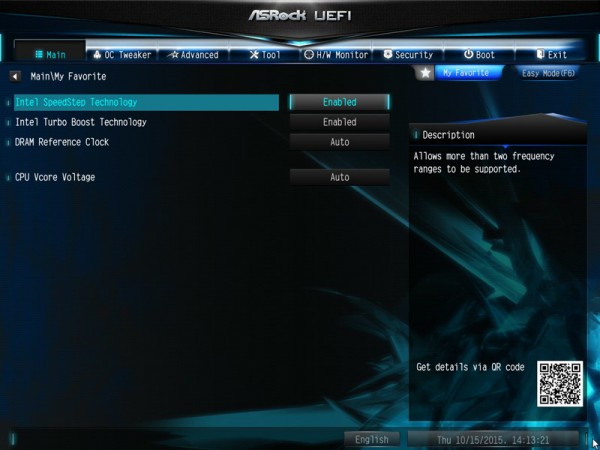
Of course, this H170 motherboard again has the selection to view the UEFI in Full HD and also offers the Active Page on Entry selection, where you can decide which UEFI page you want to see when you enter the UEFI Setup. You could just add all necessary points to the My Favorite overview and start directly to this My Favorite overview page. At the ASRock Fatality H170 Combo you find the Active Page on Entry option and the Full HD UEFI selection now in Advanced.
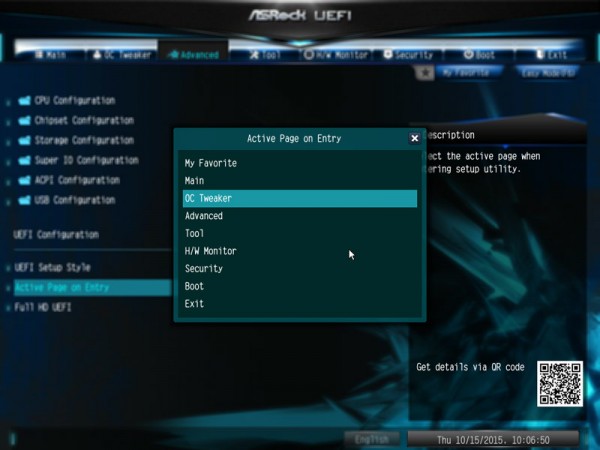
UEFI BIOS Update …
Before we begin with the UEFI settings, we first update the UEFI BIOS to the latest version.
To flash UEFI update ASRock offers some possibilities, eg the very simple Instant Flash ASRock Internet Flash or even with a direct connection to the Internet. The board is supplied with the BIOS P1.30. The time of testing the UEFI BIOS version P1.50 was available as latest download, which we updated of course immediately.
By the so-called ASRock Instant Flash option in the tool screen or via F6 during PC start you get into the ASRock Instant Flash utility. Or you can, as shown in the next image, go over the previously mentioned EZ Mode input side to Instant Flash.
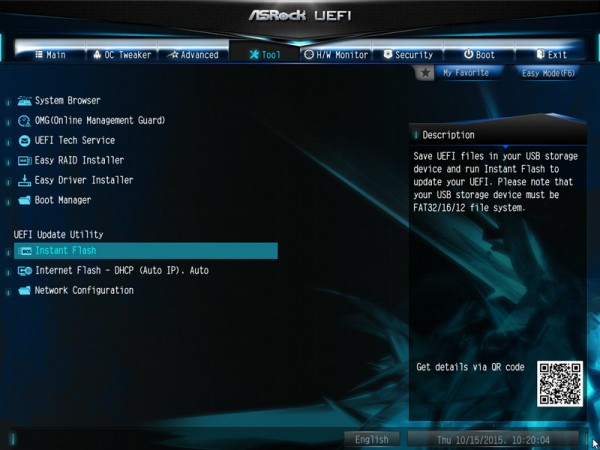
Now you can simply flash a previously downloaded ASRock BIOS without a boot CD or similar by simply starting the ASRock Instant Flash utility. Just select the BIOS Flash ROM from the desired drive, such as a USB stick and even without a boot medium it is flashed and available after a restart.
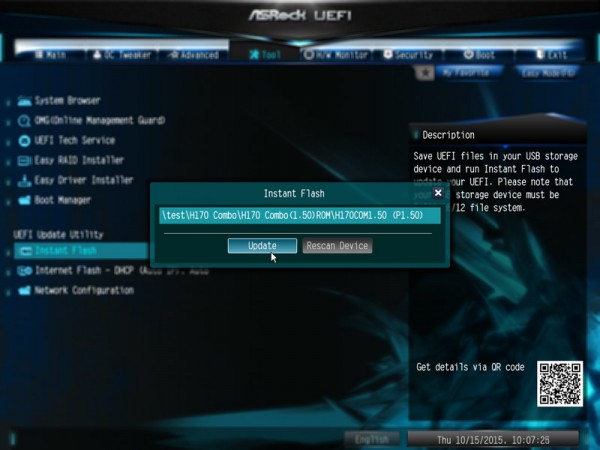
If you need technical UEFI support, you can now even contact the ASRock Tech Service over the UEFI setup and a network connection.
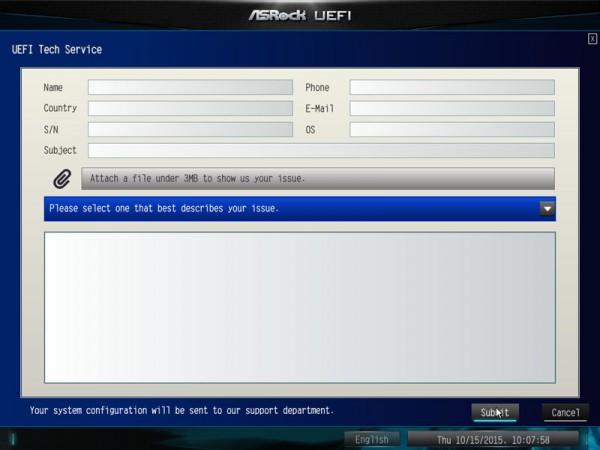
On the tool page you can also find the ASRock System Browser with the details of the latest hardware, which could, in our view, also be represented as a thumbnail view in the startup menu.
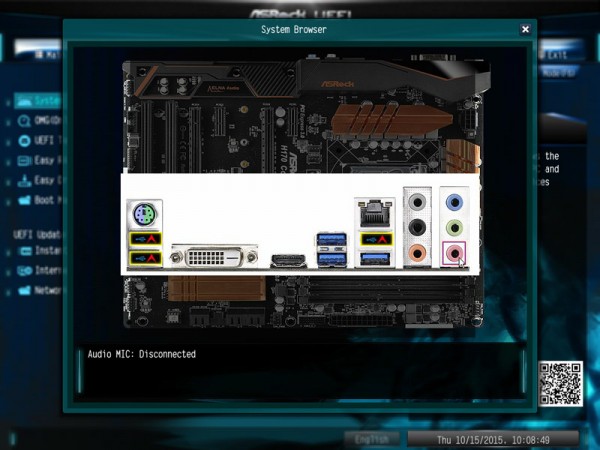
In addition, there is also the OMG – Online Management Guard, with which you can define the times and days for the Internet access. This is for example useful for parents who like to specify a fixed Internet time for their children and want to block access with a password secure in UEFI BIOS, or for companies that allow Internet access for their employees only during lunch or after regular working hours.
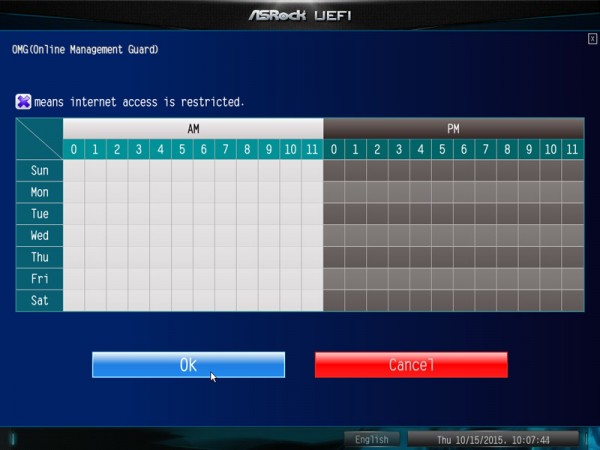
ASRock H170 Combo overclocking …
In the H170 Combo UEFI setup, there are unfortunately only a few Intel LGA1151 overclocking settings.
ASRock split the settings in CPU Configuration, DRAM Configuration and Voltage Configuration.
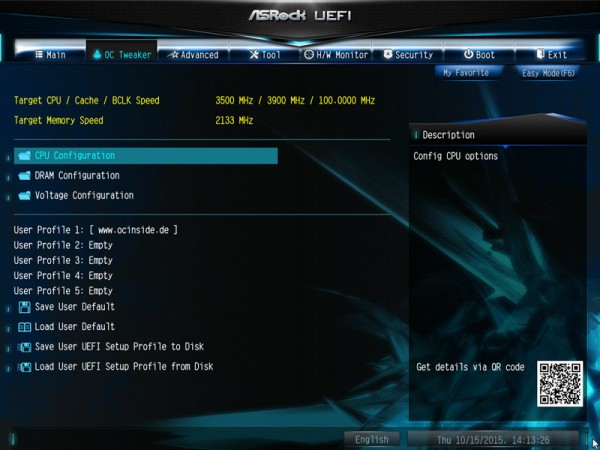
A look at the options under CPU Configuration can however not augur well, because there are no settings for the BCLK an no settings to increase the CPU multi !
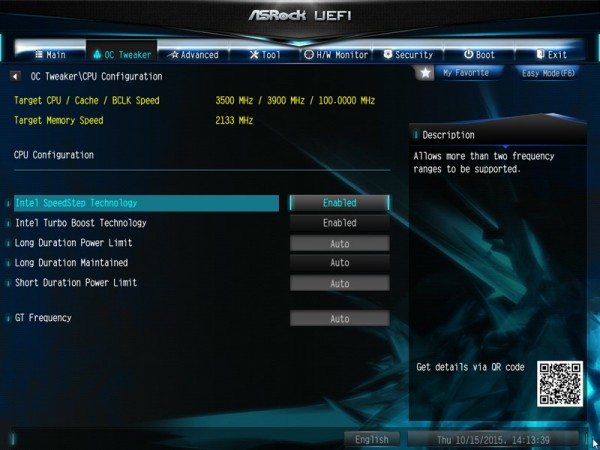
So you can overclock the H170 combo motherboard not over the base clock – short BCLK, nor by the multi. So we could even not increase the CPU frequency of our Intel Skylake “K” CPU with unlocked multiplier by the CPU multiplier !
ASRock H170 Combo memory settings …
In the DRAM Configuration Menu is an option to change the DDR4 reference clock to 100 MHz or 133 MHz.
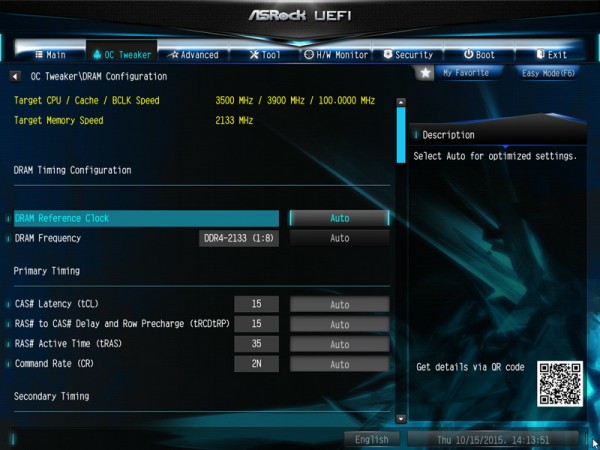
For the DDR3 memory settings you can set E.g. a speed from DDR3-800 to DDR3-1333 and for the DDR4 memory settings can change the memory speed from DDR4-800 up to DDR4-2133.
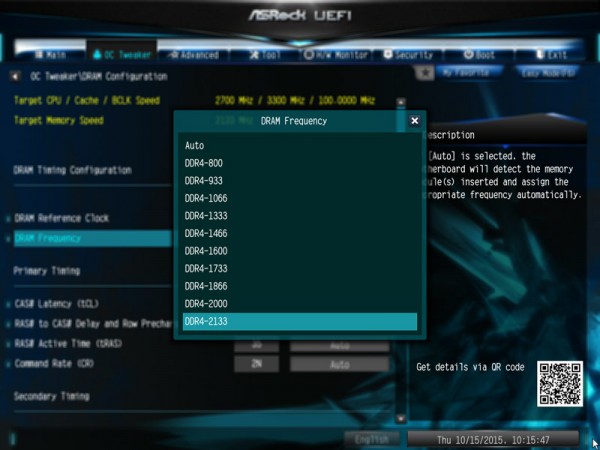
Higher clock rates are with the default BCLK frequency of 100 MHz not possible and a manual BCLK boost (see Intel OC guide) is unfortunately on the H170 chipset not yet (?) supported.
But fortunately you can adjust at least all DDR3 and DDR4 timings manually, obtaining so a little more performance from your memory modules.
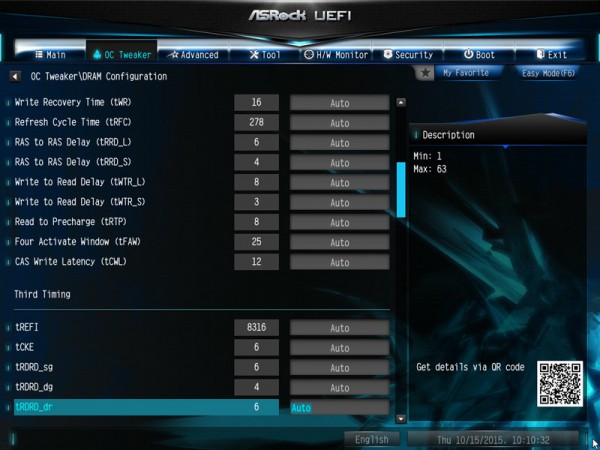
ASRock H170 Combo voltage settings …
Now we come to the voltage settings that can be adjusted in the UEFI.
To offer motherboard manufacturers a little more room for different motherboard types, the voltage regulator (FIVR) are now implemented externally on the motherboard and not anymore inside of the Intel Skylake CPU. Due to that the FIVR Configuration Menu is no longer available and we can proceed directly to the voltage configuration.
The motherboard has numerous voltage settings, such as the VCore with the Intel Core i5-6600K CPU Test from 0.900 to 1.520 volts (or offset), PCH +1.0 Voltage (chipset) from 0.900 to 1.300 volts, VCCIO Voltage Auto/High, VCCSA Voltage (System Agent voltage) Auto/High, DRAM Activating Power Supply from 2.400 to 2.800 Volt, Short Duration Power Limit, Long Duration Power Limit, Long Duration Maintained, the DDR4 voltage can be set in the BIOS from 1.200 volts to 1.800 volts, and if you use the internal graphics unit, you can select the GT Voltage from 0.900 to 1.520 Volt.
Here you can see the values for voltage configuration:
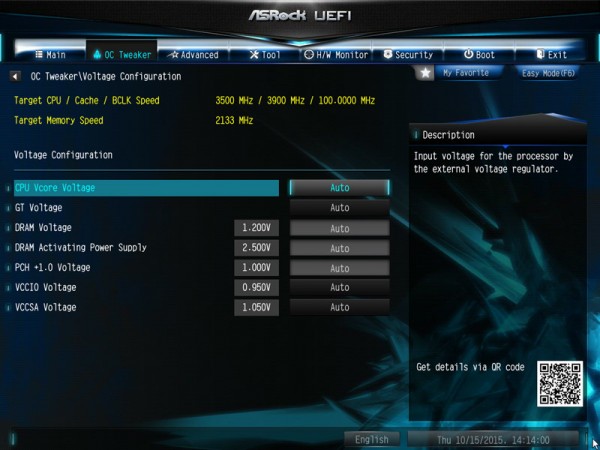
Overclock even easier …
Usually, there would be the Load Optimized CPU OC Settings at this point, but because the Intel H170 currently unfortunately unlocked no BCLK nor multi, we can left this part.
Nevertheless you can save up to five different BIOS settings with names in the UEFI under OC Tweaker, to load these settings later.
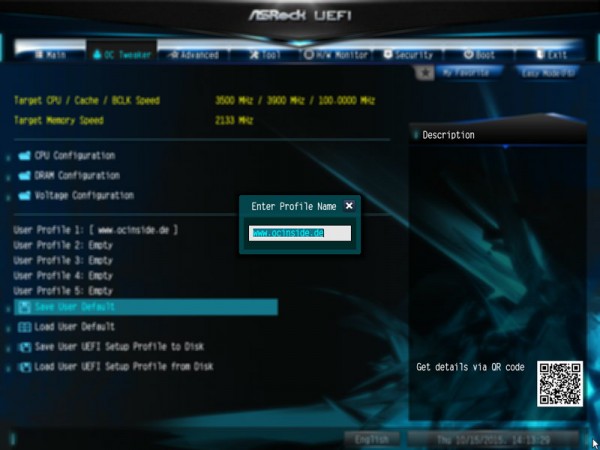
Also interesting is the “Save User UEFI Setup Profile to Disk” option. Just click and save your own UEFI settings on the hard drive or on an USB stick.
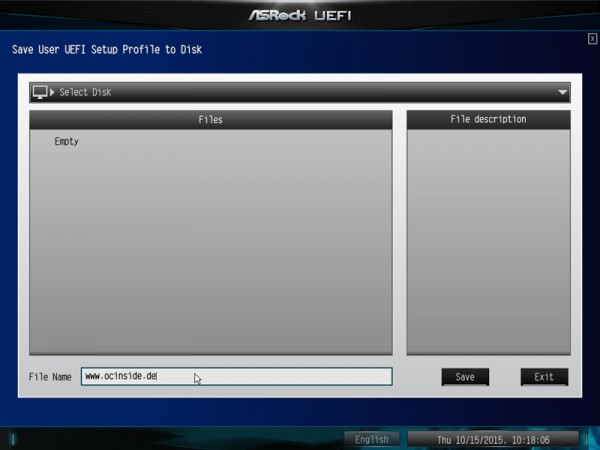
BIOS Undervolting …
The underclocking was also tested again in this review. Unfortunately you could not set a lower multi by the BIOS, even not with the Intel Core i5-6600 K CPU.
But the H170 Combo offers much more UEFI settings, there are still the CPU, Chipset, Storage, Super IO, ACPI and USB Configuration to select from.
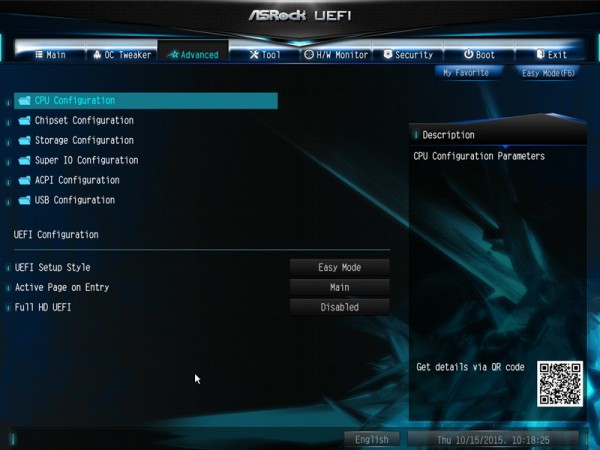
Tip:
A tip if the USB keyboard and/or USB mouse does not work in Windows 7, because no driver has been installed: ASRock provides in the USB Configuration a PS/2 Simulator selection, which can easily be activated, and afterwards you can use the keyboard and mouse in Windows. Or with the Windows 7 USB Patcher to directly integrate the corresponding Intel USB 3.0 eXtensible host controller – short xHCI drivers in the Windows 7 ISO file.
Who wants to save power with Intel Core i3, i5 or i7 PC, should also go through the settings necessarily in CPU Configuration menu in Advanced.
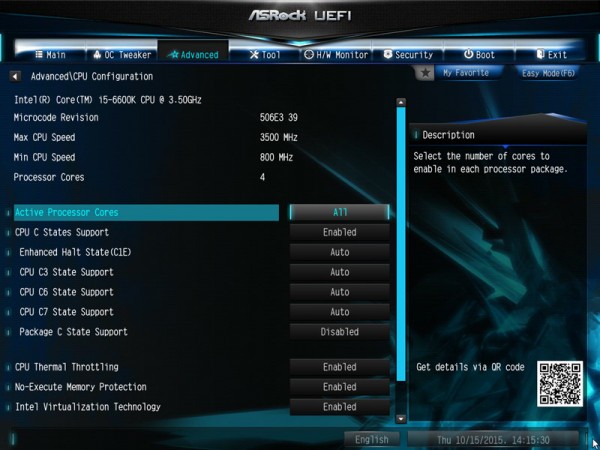
But the other settings, like the Advanced Chipset Configuration Menu are not unimportant as well.
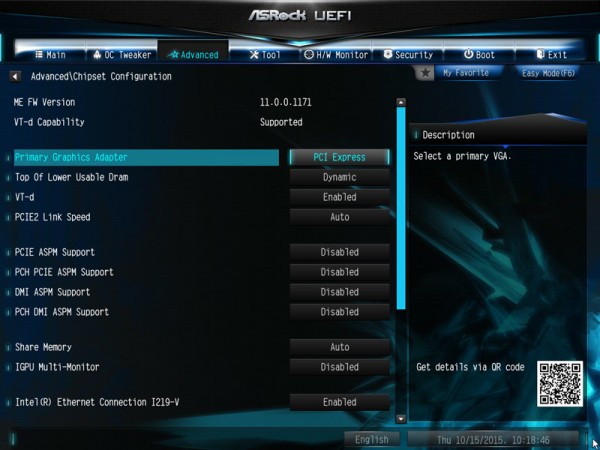
Fan control …
The UEFI setup of passively cooled H170 Combo motherboard has an extensive, temperature-controlled fan controller for the 4-pin CPU Fan, CPU Fan 1 and 2, as well as the 4-pin Chassis Fans – Chassis Fan 1 to 3.
The settings for the fan controller can be found in the H/W monitor directly below the extensive display of temperature and voltage values.
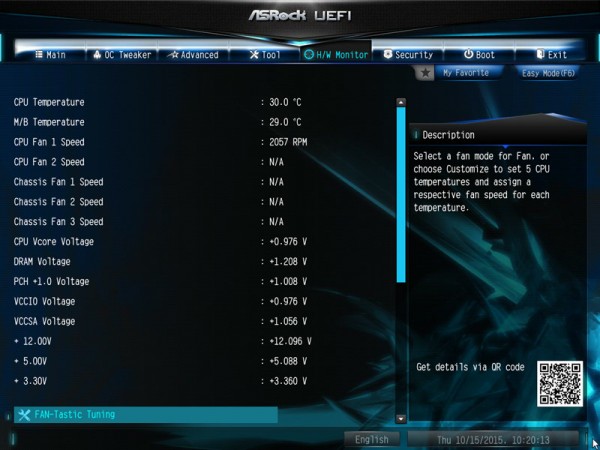
In the fan control you have the choice between Customize, Silent, Standard, Performance and Full Speed and in Customize mode several temperature steps are available, where you can assign a particular fan speed.
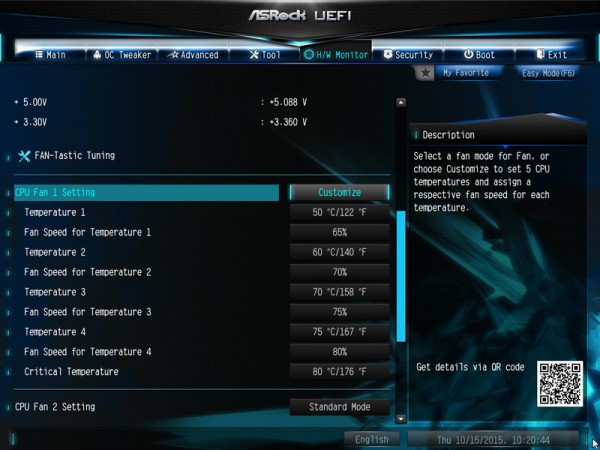
Because the fans are controlled with this fan control based on the CPU or the motherboard temperature, you can usually get along without an expensive fan control.
But that’s not enough, so ASRock has even implemented, as shown in the X99 reviews, a graphical interface for controlling the fan is integrated in the UEFI setup. You can find the FAN-Tastic Tuning menu also in the H/W monitor and thus can make all the settings very clearly. Simply select the respective fan connector on the left and you can select the mode – e.g. Performance on the right side.
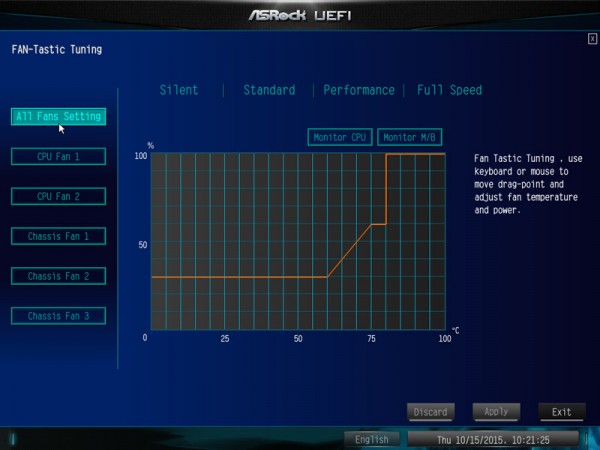
In Customize mode you can even set all the values directly in the chart and save them.
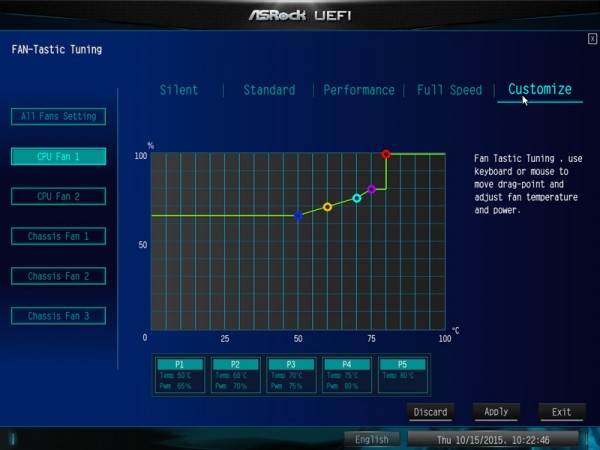
Regarding the Chassis Fan connectors you can select which source you want to use for temperature measurement: Monitor CPU sensor or monitor motherboard sensor. Then just click Apply or exit the menu and save the values.
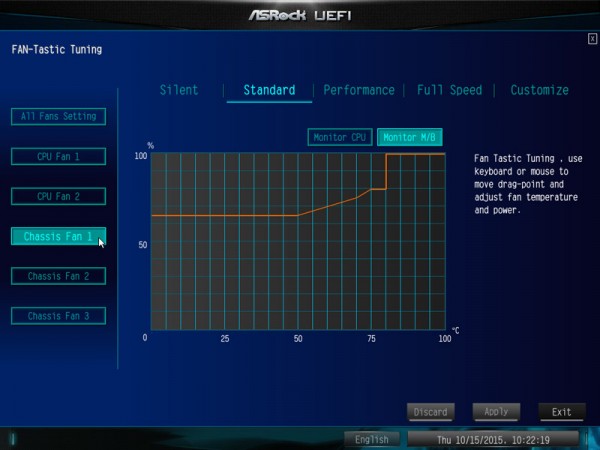
The fan control can also be conveniently set via the supplied ASRock Tuning tool. First, you start the fan test to determine all possible rotation speeds, and then you can adjust the temperature curve as desired. The ASRock A-Tuning software offers many other tools, such as temperature monitoring and some OC settings OC Tweaker menu.
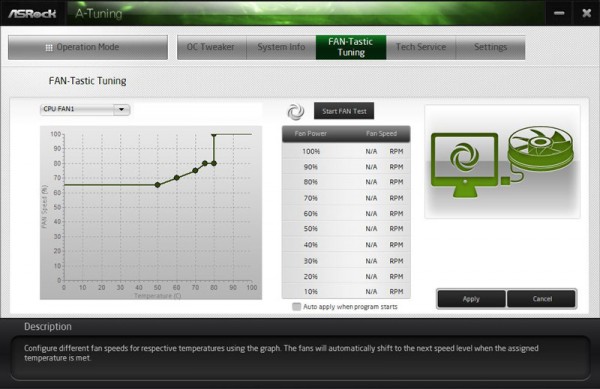
Energy consumption …
The PC power consumption will vary depending on hardware and PC load. The power consumption of the test PC with Intel Core i5-6600K LGA 1151 CPU hard drive and Cooler Master Silent Pro M 600W PSU was without overclocking depending on load at the following consumption:
– With MSI Radeon R9 280 graphics card and 2x 4GB DDR4 RAM the entire H170 PC Power Consumption was 44.6W idle and 250.9W.
– With integrated Intel HD Graphics GPU 530 and 2x 4GB DDR4 the total consumption was 27.2W idle and 62.8 watts at full load.
– With integrated Intel HD Graphics GPU 530 and 2x 2GB DDR3 the total consumption was 30.5W idle and 67.4 watts at full load.
An ASRock Z170 Extreme6 motherboard with an Intel Core i5-6600K LGA1151 CPU and 4x 4GB DDR4 memory had the following power consumption:
– With MSI Radeon R9 280 graphics card the entire power consumption was 50.5W idle and full load 256.1W.
– With integrated Intel HD Graphics GPU 530 the total consumption was 36.0W idle and 70.7 Watt at full load.
An ASRock X99 Extreme6 motherboard with an Intel Core i7-5930K LGA2011-3 CPU had the following power consumption:
– With MSI Radeon R9 280 between 60.5W idle and 290.4W load.
An ASRock Z97 Extreme6 motherboard with an Intel Core i5-4670K CPU had the following power consumption:
– With MSI Radeon R9 280 between 53.1W idle and 270.7W load.
– With Sapphire HD6870 graphics card the entire power consumption was 55.8W idle and 219.5W full load.
– With integrated Intel HD Graphics 4600 GPU the total consumption was 33.5W idle and 94.5 Watt full load.
An ASRock Fatal1ty FM2A88X+ Killer motherboard with an AMD A10-7850K Kaveri APU had the following PC energy consumption:
– With Sapphire HD6870 between 56.3W idle and 233.5 Watt full load.
– With internal AMD Radeon R7 GPU between 30.2W idle and 118.8 Watt full load.
An ASRock FM2A85X-ITX motherboard with an AMD A10-5800K Trinity APU had the following power consumption:
– With Sapphire HD6870 graphics card from 52.9W to 221.0 Watt.
– With internal AMD Radeon HD7660D GPU 29.4W idle and 120.4 Watt full load.
ASRock H170 Combo Result and general impression …

